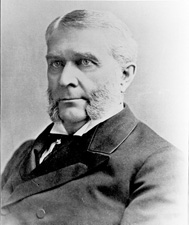
William Drew "W.D." Washburn, Sr. was an American politician. He served in both the United States House of Representatives and the United States Senate as a Republican from Minnesota. Three of his seven brothers became politicians: Elihu B. Washburne, Cadwallader C. Washburn, and Israel Washburn, Jr. He was also cousin of Dorilus Morrison, the first mayor of Minneapolis. He served in the 46th, 47th, 48th, 51st, 52nd, and 53rd congresses.
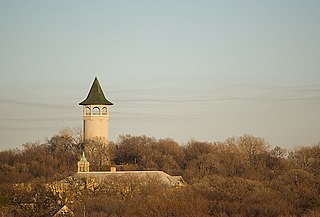
Prospect Park is a historic neighborhood within the University community of the U.S. city of Minneapolis, Minnesota. The area is bounded by the Mississippi River to the south, the City of Saint Paul, Minnesota to the east, the Burlington Northern railroad yard to the north, and the Stadium Village commercial district of the University of Minnesota to the west. The neighborhood is composed of several districts which include the East River Road area. The 1913 Prospect Park Water Tower is a landmark and neighborhood icon.
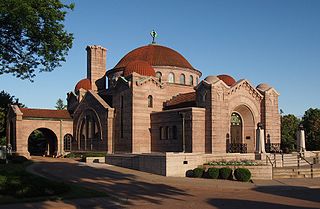
Lakewood Cemetery is a large private, non-sectarian cemetery located in Minneapolis, Minnesota, United States. It is located at 3600 Hennepin Avenue at the southern end of the Uptown area. It is noted for its chapel which is on the National Register of Historic Places and was modeled after the Hagia Sophia in Istanbul, Turkey.

The Washburn Park Water Tower is a landmark in the Tangle town neighborhood of south Minneapolis, Minnesota, built in 1931. It is located on top of one of the highest points of south Minneapolis. The tower is considered an unofficial "beacon" for incoming planes landing at Minneapolis-Saint Paul International Airport; however, it is not as visible to passers-by at the base of the hill due to the large homes and tall oak trees scattered on the hillside.
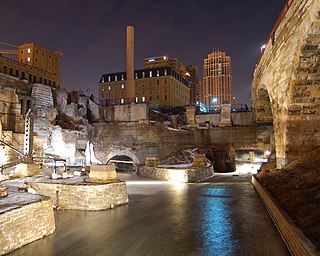
Mill Ruins Park is a park in downtown Minneapolis, Minnesota, United States, standing on the west side of Saint Anthony Falls on the Mississippi River and running from 3rd Ave. S. to about 9th Ave. S. The park interprets the history of flour milling in Minneapolis and shows the ruins of several flour mills that were abandoned.

The Washburn-Fair Oaks Mansion District is a historic district in the Whittier neighborhood of Minneapolis, Minnesota, United States, centered on Washburn-Fair Oaks Park. The city of Minneapolis designated a district bordered by Franklin Avenue, Fourth Avenue South, 26th Street East, and First Avenue South. A smaller district, listed on the National Register of Historic Places, includes seven mansions along and near 22nd Street East.
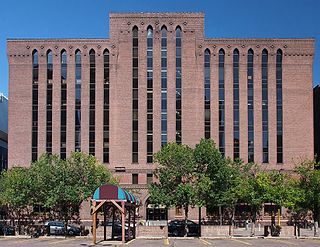
Butler Square is a former warehouse and office building in Minneapolis, Minnesota, United States. The building is located within the Minneapolis warehouse district and was listed on the National Register of Historic Places in 1971. It is significant for its restrained Chicago School design by major Minneapolis architect Harry Wild Jones, and as a leading example of the older warehouse/office buildings in Minneapolis–Saint Paul. Jones designed other buildings in Minneapolis such as the Minneapolis Scottish Rite Temple, Calvary Baptist Church, the Lakewood Cemetery Chapel, and the Washburn Park Water Tower.

The First Church of Christ, Scientist building in Minneapolis, Minnesota, was the first of its kind in the state.

The Church of Saint Stephen is a historic Roman Catholic church in the Whittier neighborhood of Minneapolis in the U.S. state of Minnesota. This neighborhood is where entrepreneurs and businessmen built their mansions in the modern-day Washburn-Fair Oaks Mansion District. The building was built with sandstone, brick, concrete, and copper in 1889–1891.

Harry Wild Jones was an American architect based in Minneapolis who designed throughout the country and the world. Born two years before the start of the American Civil War, Jones, a twelfth-generation New Englander, took his place on the American architectural stage in the late 19th century. His life spanned seventy-six years, during a period of U.S. history that matched his exuberant, spirited personality. Known as an architect adept at any design technique, Jones is credited with introducing Shingle Style architecture to Minneapolis. He created an impressive portfolio from neoclassic to eclectic, reflecting his unique brand of versatility and creativity.

This list is of the properties and historic districts which are designated on the National Register of Historic Places or that were formerly so designated, in Hennepin County, Minnesota; there are 190 entries as of April 2023. A significant number of these properties are a result of the establishment of Fort Snelling, the development of water power at Saint Anthony Falls, and the thriving city of Minneapolis that developed around the falls. Many historic sites outside the Minneapolis city limits are associated with pioneers who established missions, farms, and schools in areas that are now suburbs in that metropolitan area.


The Scottish Rite Temple, formerly the Fowler Methodist Episcopal Church, is a historic church building in the Lowry Hill neighborhood of Minneapolis, Minnesota, United States. It was designed by architects Warren H. Hayes and Harry Wild Jones. The original portion, the rear chapel, was designed by Warren H. Hayes and built in 1894. When the congregation expanded and more funds were available, Harry Wild Jones designed an addition that expanded it to a much larger structure. This was completed in 1906.

The Swinford Townhouses and Apartments are a development of townhouses and apartments in the Loring Park neighborhood of Minneapolis, Minnesota, United States. Both buildings are located in an area that surrounded the once-elegant Hawthorne Park. The townhomes were built first, in 1886 by Hodgson & Sons in the Second Empire style, using red brick, stone, and terra cotta. The apartments were designed in 1897 by locally prominent architect Harry Wild Jones, who preferred an eclectic style. The building is four stories tall, built of red brick and stone, and features a corner bay. They were built by Anthony Kelly, a nineteenth-century businessman who pioneered the wholesale grocery business in Minneapolis. Both the townhouses and the apartments were listed on the National Register of Historic Places in 1990. The apartments are now incorporated in the Laurel Village development.

Edward Townsend Mix was an American architect of the Gilded Age who designed many buildings in the Midwestern United States. His career was centered in Milwaukee, Wisconsin, and many of his designs made use of the region's distinctive Cream City brick.

Mill City Museum is a Minnesota Historical Society museum in Minneapolis. It opened in 2003 built in the ruins of the Washburn "A" Mill next to Mill Ruins Park on the banks of the Mississippi River. The museum focuses on the founding and growth of Minneapolis, especially flour milling and the other industries that used hydropower from Saint Anthony Falls.
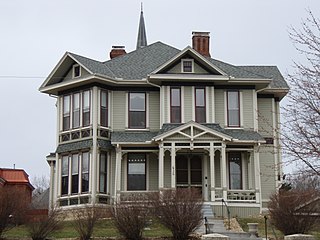
George W. Orff (1835-1908), was an American architect of Bangor, Maine and Minnesota.
The Benjamin C. Wilder House is an historic house at 1267 Main Street in Washburn, Maine, United States. Built about 1852, it is a well-preserved example of mid-19th century vernacular architecture in northern Aroostook County, built in the first decade after widespread settlement began of the area. The house was listed on the National Register of Historic Places in 1987. It is now owned by the local Salmon Brook Historical Society and operated as a historic house museum.





















